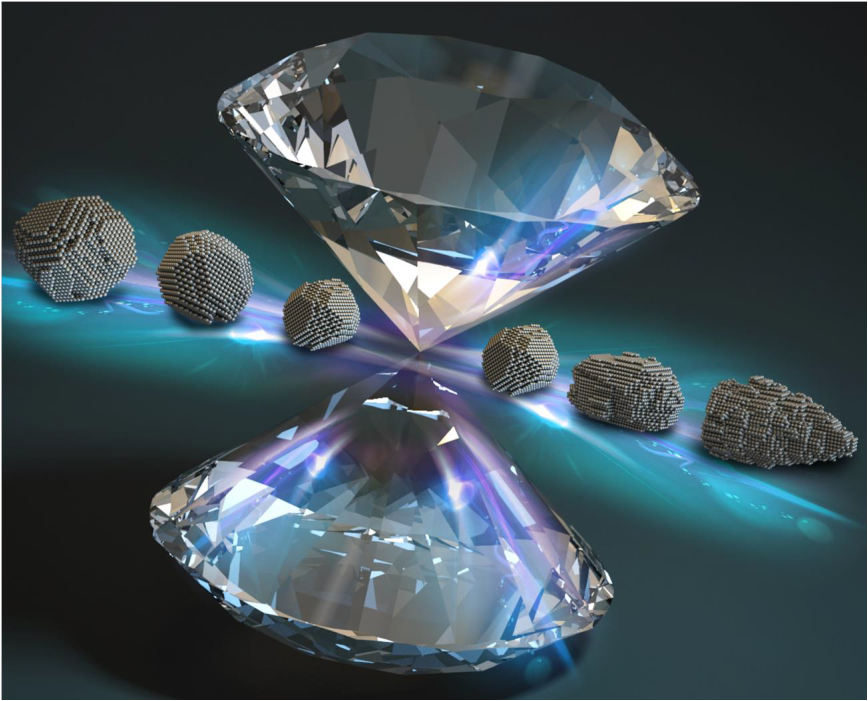The smaller, the stronger - Dr. Bin Chen
FEBRUARY 25, 2020
According to the well-known Hall-Petch relationship, the strength of nanometals decreases when the grain size is smaller than 10 to 15 nanometers. New high-pressure compression study from a team of scientists led by Dr. Bin Chen from HPSTAR and Prof. Xiaoxu Huang from Chongqing University detected the strengthening in nano-grained nickel down to 3 nanometers. The yield strength of the 3-nanometer-grain-size sample is ten times greater that of a common commercial nickel material. The work is published in Nature (DOI: 10.1038/s41586-020-2036-z).
The strength of metals usually increases with decreasing grain sizes in the conventional theories of mechanics, whereas below a critical size around 10-15 nm, the strength of nanometals will no longer increase with decreasing grain sizes. This is attributed to the shift from dislocations-dominated to grain boundary sliding-dominated deformation mechanism.
However, there were no direct experimental measurements on the strength of nano grains below 10-15 nm due to the technical limitation in traditional mechanical measurements at such small nanoscales.
The research team utilized a technique called X-ray radial diffraction method combined with DAC technique which is usually used by geosciences community for deformation studies on minerals. They introduced the first this technique to the deformation studies of nanomaterials.
They chose eight sizes nickel samples with grain size ranging from 3 nm to 200 nm for the size-dependent strength study. Why nickel? “Firstly, nickel is a metal with a simple face-centered cubic structure. Its diffraction signals are decently strong for analysis. Secondly, it is difficult to make ultrafine nanocrystals. Fortunately, we had the finest grain size, 3 nm nickel, on hand. So we had a great chance to study the grain size effect on the strength,” explained Dr. Bin Chen.
From their high-pressure measurements, they were surprised to observe a continuous strengthening in nickel samples with grain sizes from 200 nanometres down to 3 nanometres, with the strengthening enhanced rather than reduced at grain sizes smaller than 20 nanometres. “The yield strength and flow stresses in the smallest grain sized nickel is three times higher than that of the larger grain sized, which means that smaller is still stronger even down to 3 nm,” said Dr. Bin Chen. “This is at odds with the traditional belief on the size softening below 10-15 nm.”
This work is the first experimental observation on the strength of nanometal with a grain size below 10 nm and also the first report on grain size strengthening in sub-10 nm pure metal.
To explore the reasons for this continuous size strengthening, they further simulated the deformation process on different grain-sized samples under compression and carried out high resolution TEM measurements on the eight recovered samples from high-pressure. The theoretical calculation combined with TEM results revealed that the enhanced strengthening effect in grain size below 20 nm is caused by the partial and full dislocation hardening plus the suppression of grain boundary plasticity.
“This is the first study revealing that partial-mediated deformation contributes significantly to the enhanced strengthening at small grain size,” said Dr. Bin Chen, “Our results suggest possible strategies for getting ultra-strong metals through grain refinement and suppression of grain boundary plasticity.

Caption: Strength measurements of nanometals with radial Diamond-anvil cell X-ray diffraction: the smaller, the less deformed, thus the stronger.
Media Reports:
Phys. Org: https://phys.org/news/2020-02-super-small-strong-metals.html
ScienceDaily: https://www.sciencedaily.com/releases/2020/02/200224111337.htm
SciTechDaily:https://scitechdaily.com/microscopic-refinement-yields-ultra-strong-metal/
科学网:http://news.sciencenet.cn/sbhtmlnews/2020/2/353547.shtm
光明日报:http://news.gmw.cn/2020-02/25/content_33590636.htm?s=gmwreco2
知社学术圈:https://mp.weixin.qq.com/s/W1bfvkgmv2dGsPX3XI68KA
材料科学与工程(公众平台):https://mp.weixin.qq.com/s/ibfQgb4vq9bH0ojmLX8Hww
金属材料的强度往往伴随晶粒尺寸的减小而增加,然而当晶粒尺寸小于某临界尺寸(~10-15纳米)时,由于大量晶界活动的存在纳米金属会出现软化现象。最近,北京高压科学研究中心陈斌研究员与重庆大学黄晓旭教授合作的研究团队发现在高压下纳米镍从晶粒尺寸20纳米至3纳米并未软化而是持续强化。3纳米镍在高压下的强度可以达到普通商用镍强度的10倍之多。他们的研究提供了一种获得高强度金属的新途径。相关研究以“High pressure strengthening in ultra-fine-grained metals”为题近期发表于国际顶级期刊Nature。
